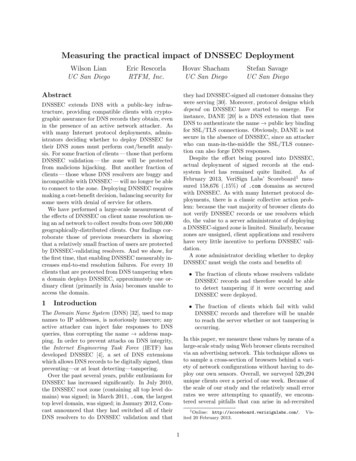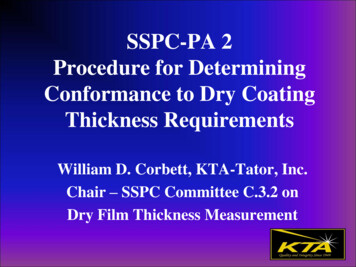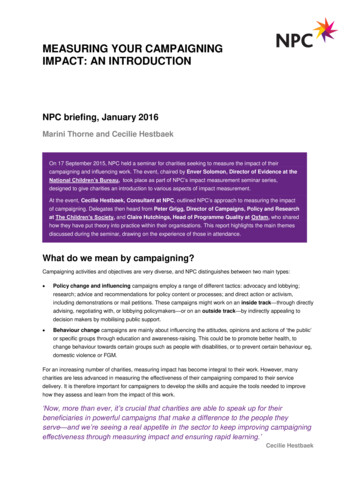
Transcription
Measuring the practical impact of DNSSEC DeploymentWilson LianUC San DiegoEric RescorlaRTFM, Inc.Hovav ShachamUC San DiegoAbstractthey had DNSSEC-signed all customer domains theywere serving [30]. Moreover, protocol designs whichdepend on DNSSEC have started to emerge. Forinstance, DANE [20] is a DNS extension that usesDNS to authenticate the name public key bindingfor SSL/TLS connections. Obviously, DANE is notsecure in the absence of DNSSEC, since an attackerwho can man-in-the-middle the SSL/TLS connection can also forge DNS responses.Despite the effort being poured into DNSSEC,actual deployment of signed records at the endsystem level has remained quite limited. As ofFebruary 2013, VeriSign Labs’ Scoreboard1 measured 158,676 (.15%) of .com domains as securedwith DNSSEC. As with many Internet protocol deployments, there is a classic collective action problem: because the vast majority of browser clients donot verify DNSSEC records or use resolvers whichdo, the value to a server administrator of deployinga DNSSEC-signed zone is limited. Similarly, becausezones are unsigned, client applications and resolvershave very little incentive to perform DNSSEC validation.A zone administrator deciding whether to deployDNSSEC must weigh the costs and benefits of:DNSSEC extends DNS with a public-key infrastructure, providing compatible clients with cryptographic assurance for DNS records they obtain, evenin the presence of an active network attacker. Aswith many Internet protocol deployments, administrators deciding whether to deploy DNSSEC fortheir DNS zones must perform cost/benefit analysis. For some fraction of clients — those that performDNSSEC validation — the zone will be protectedfrom malicious hijacking. But another fraction ofclients — those whose DNS resolvers are buggy andincompatible with DNSSEC — will no longer be ableto connect to the zone. Deploying DNSSEC requiresmaking a cost-benefit decision, balancing security forsome users with denial of service for others.We have performed a large-scale measurement ofthe effects of DNSSEC on client name resolution using an ad network to collect results from over 500,000geographically-distributed clients. Our findings corroborate those of previous researchers in showingthat a relatively small fraction of users are protectedby DNSSEC-validating resolvers. And we show, forthe first time, that enabling DNSSEC measurably increases end-to-end resolution failures. For every 10clients that are protected from DNS tampering whena domain deploys DNSSEC, approximately one ordinary client (primarily in Asia) becomes unable toaccess the domain.1Stefan SavageUC San Diego The fraction of clients whose resolvers validateDNSSEC records and therefore would be ableto detect tampering if it were occurring andDNSSEC were deployed.Introduction The fraction of clients which fail with validDNSSEC records and therefore will be unableto reach the server whether or not tampering isoccurring.The Domain Name System (DNS) [32], used to mapnames to IP addresses, is notoriously insecure; anyactive attacker can inject fake responses to DNSqueries, thus corrupting the name address mapping. In order to prevent attacks on DNS integrity,the Internet Engineering Task Force (IETF) hasdeveloped DNSSEC [4], a set of DNS extensionswhich allows DNS records to be digitally signed, thuspreventing—or at least detecting—tampering.Over the past several years, public enthusiasm forDNSSEC has increased significantly. In July 2010,the DNSSEC root zone (containing all top level domains) was signed; in March 2011, .com, the largesttop level domain, was signed; in January 2012, Comcast announced that they had switched all of theirDNS resolvers to do DNSSEC validation and thatIn this paper, we measure these values by means of alarge-scale study using Web browser clients recruitedvia an advertising network. This technique allows usto sample a cross-section of browsers behind a variety of network configurations without having to deploy our own sensors. Overall, we surveyed 529,294unique clients over a period of one week. Because ofthe scale of our study and the relatively small errorrates we were attempting to quantify, we encountered several pitfalls that can arise in ad-recruited1 Online:http://scoreboard.verisignlabs.com/.ited 20 February 2013.1Vis-
browser measurement studies. Our experience maybe relevant to others who wish to use browsers formeasurements, and we describe some of these resultsin Section 4.2.(Root)eduEthics. Our experiment runs automatically without user interaction and is intended to measure thebehavior and properties of hosts along the pathsfrom users to our servers rather than the users themselves. We worked with the director of UC SanDiego’s Human Research Protections Program, whocertified our study as exempt from IRB ure 1: Example DNS name tree. Shaded boxesrepresent zone boundaries. Edges that cross zoneboundaries are delegations.A DNS name is a dot-separated concatenation oflabels; for example, the name cs.ucsd.edu is comprised of the labels cs, ucsd, and edu. The DNSnamespace is organized as a tree whose nodes arethe labels and whose root node is the empty stringlabel. The name corresponding to a given node inthe tree is the concatenation of the labels on the pathfrom the node to the root, separated by periods.Associated with each node are zero or more resource records (RRs) specifying information of different types about that node. For example, IP addresses can be stored with type A or AAAA RRs,and the name of the node’s authoritative nameservers can be stored in type NS RRs. The set ofall RRs of a certain type2 for a given name is referred to as a resource record set (RRset).(1) cs.ucsd.edu IN A?LANRouter(10) cs.ucsd.edu IN A1.2.3.4Desktop PC(2) cs.ucsd.edu IN A?(9) cs.ucsd.edu IN A1.2.3.4(3) cs.ucsd.edu IN A?(4) edu IN NS a.edu-servers.neta.edu-servers.net IN A x.x.x.xRoot DNS Server?NAuI.edcsdu.cs(5)ISP's RecursiveDNS Resolver(7(6) ucsd.edu IN NS ns0.ucsd.eduns0.ucsd.edu IN A y.y.y.yedu DNS ) cs.ucsd.edu IN A1.2.3.4.eduINA?ucsd.edu DNS Serverns0.ucsd.eduy.y.y.yFigure 2: Simplified DNS address resolution procedure for cs.example.tld. In this example, thereare at most one nameserver and one IP address pername.DNS is a distributed system, eliminating the needfor a central entity to maintain an authoritativedatabase of all names. The DNS namespace treeis broken up into zones, each of which is ownedby a particular entity. Authority over a subtreein the domain namespace can be delegated by theowner of that subtree’s parent. These delegationsform zone boundaries. For example, a name registrar might delegate ownership of example.comto a customer, forming a zone boundary between.com and example.com while making that customerthe authoritative source for RRsets associated withexample.com and its subdomains. The customer canfurther delegate subdomains of example.com to another entity. Figure 1 depicts an example DNS tree.2.2comucsd.eduOverview of DNS and DNSSEC2.1orgtype A or AAAA RRsets). Domain name resolution is performed in a distributed, recursive fashionstarting from the root zone, as shown in Figure 2.Typically, end hosts do not perform resolution themselves but instead create DNS queries and send themto recursive resolvers, which carry out the resolutionto completion on their behalfs. When a nonrecursiveDNS server receives a query that it cannot answer, itreturns the name and IP address of an authoritativename server as far down as possible along the pathto the target domain name. The recursive resolverthen proceeds to ask that server. In this fashion,the query eventually reaches a server that can answer the query, and the resolution is complete. Thisrecursive process is bootstrapped by hardcoding thenames and IP addresses of root nameservers into endhosts and recursive resolvers.Address resolutionThe most important DNS functionality is the resolution of domain names to IP addresses (retrieving2 Andclass, but for our purposes class is always IN, for“Internet.”2
2.3DNS (in)securitypublic key. If a chain of trust can be constructedall the way to the trust anchor, then the validatingresolver can have confidence that the information inthat RR is correct — or at least that it is cryptographically authenticated.Because DNSSEC is a retrofit onto the existing insecure DNS, it is explicitly designed for incremental deployment, and insecure (i.e., unsigned)domains can coexist with secure domains. Thus,DNSSEC-capable resolvers should be able to resolve unsigned domains, and non-DNSSEC resolversshould be able to resolve DNSSEC-signed domains,though of course they will not gain any securityvalue. In order to make this work, DNSSEC recordsare designed to be backwards-compatible with existing resolvers, and DNSSEC resolvers are able todistinguish zones which simply are not signed fromthose which are signed but from which an attackerhas stripped the signatures (the DS record is usedfor this purpose).Unfortunately, while DNSSEC is designed to bebackwards compatible, it is known [9] that thereare some network elements which do not processDNSSEC records properly. The purpose of this workis to determine the frequency of such elements and inparticular their relative frequency to elements whichactually validate DNSSEC signatures and thus benefit from its deployment.The original DNS design did not provide any mechanisms to protect the integrity of DNS response messages. Thus, an active network attacker can launcha woman-in-the-middle attack to inject her own responses which would be accepted as if they were legitimate. This attack is known as DNS spoofing.Moreover, because recursive resolvers typically cacheresponses, a single spoofed response can be used toperform a DNS cache poisoning attack, which results in future responses to requests for the sameRRset returning the bogus spoofed response. Themechanisms by which DNS cache poisoning is carried out are outside the scope of this work but havebeen studied more formally in [38]. DNS spoofingand cache poisoning may be used to compromise anytype of DNS RR.2.4DNSSEC to the rescueThe Domain Name System Security Extensions(DNSSEC) [4], aim to protect against DNS spoofing attacks by allowing authoritative nameservers touse public key cryptography to digitally sign RRsets.Security-aware recipients of a signed RRset are ableto verify that the RRset was signed by the holder ofa particular private key, and a chain of trust fromthe root zone downwards ensures that a trusted keyis used to validate signatures.While DNSSEC adds a number of new RR types,the DNSKEY, RRSIG, DS only the records are relevant for our purposes; we describe them briefly here.DNSKEY: DNSKEY records are used to holdpublic keys. Each zone authority generates at leastone public/private key pair, using the private keysto sign RRsets and publishing the public keys inDomain Name System Key (DNSKEY) resourcerecords.RRSIG: When a zone is signed, a resource recordsignature (RRSIG) resource record is generated foreach RRset-public key pair. In addition to containing a cryptographic signature and the name and typeof the RRset being signed, the RRSIG RR specifiesa validity window and the name of the signing key’sowner.DS: Lastly, the Delegation Signer (DS) RR typelinks signed zones to establish the chain of trust.Each DS RR contains the digest of one of the subzone’s DNSKEY RRs.DNSSEC’s security is built on the chain of trustmodel. Starting from a “trust anchor,” a validatorattempts to trace a chain of endorsements from theroot all the way to the RRset being validated; I.e.,that each DNSKEY or DS record along the path andthe final RRSet is correctly signed by the parent’s3MethodologyIn order to address this question, we conducted alarge-scale measurement study of web browsers inthe wild. In particular, we sought to measure twoquantities: What fraction of clients validate DNSSECrecords and therefore would be able to detecttampering if it were occurring and DNSSECwere deployed? What fraction of clients fail with valid DNSSECrecords and therefore will be unable to reach theserver whether or not tampering is occurring?Answering these questions requires taking measurements from a large number of clients. We gathered our clients by purchasing ad space from an online advertising network; the ad network enabled usto host an ad at a fixed URL which would be loadedin an iframe on various publishers’ web sites. Ourad included JavaScript code to drive the experimentand was executed without any user interaction uponthe loading of the ad iframe in clients’ browsers. Inorder to minimize sampling bias, our ad campaigndid not target any particular keywords or countries.3
However, because our measurements were sensitiveto the reliability of the participants’ Internet connections, we configured our ad campaign to targetdesktop operating systems, to the exclusion of mobile users.Our client-side “driver script” (discussed in detailin § 3.1) induces participants’ browsers to load 1 1pixel images (“test resources”) from various domains.This is a standard technique for inducing the browserto load resources from different origins than the containing document. These domains fall into the following three classes:Publisher's web pageAd-network iframe 1Ad-network iframe 2Static ad URL iframeMeasurement pageDummyimageTestresourcejQuery.js.JSON libTestresourceFigure 3: Client-side experiment setup nosec — without DNSSEC goodsec — with correctly-configured DNSSECpoints to the iframe wrapping the ad. Our ad pageresiding at the static URL iframes the measurement page, which contains the JavaScript driverprogram. Each instance of the measurement pageand all requests generated by it are linked by a version 4 UUID [29] placed in both the URL querystring and the domain name (with the exceptionof the measurement page, which only has it in thequery string).The measurement page loads a dummy ad imageand 3 pieces of JavaScript which are the following: badsec — with DNSSEC against which we simulate misconfiguration or tampering by an activenetwork attackerThe goodsec and badsec zones were signed with1024-bit keys3 using RSA-SHA1.If we observe an HTTP request for a test resource,we conclude that the participant’s browser was ableto resolve that type of domain. Otherwise, we conclude that it was not.These three domain classes allow us to assess theclient/resolver’s DNSSEC behavior. The nosec domain class serves as a control, representing the stateof the majority of the sites on the web. Failed loadsfrom the goodsec domain class allow us to measurethe fraction of clients which would not be able toreach a DNSSEC-enabled site, even in the absenceof an attack. Failed loads from the badsec domainclass tell us about the fraction of clients which detectand react to DNSSEC tampering.During each ad impression, the driver script attempts to resolve and load a total of 27 test resources. They are distributed as follows: one nosecdomain, one goodsec domain, and 25 different badsecdomains. Each badsec variant simulates an attackagainst DNSSEC at a different point in the chain oftrust, and as we will see in Section 4, certain validating resolvers exhibit bugs that cause some badsecdomains to be treated as correctly-signed.3.1TestresourceDriverscript A minified jQuery4 [26] library hosted byjquery.com A JSON encoding and decoding library hostedon our servers The experiment’s JavaScript “driver script”The measurement page body’s onLoad handlercommences the experiment by invoking the driverscript. The driver script randomizes the order of alist of nosec, goodsec, and badsec domains then iterates over that list, creating for each domain animage tag whose source property points to an imagehosted on that domain. The creation of the imagetag causes the participant’s browser to attempt toresolve the domain name and load an image from it.Because we need to gather data for all domains in thelist before the participant navigates away from theweb page containing the ad, the driver script doesnot wait for each image to complete its load attemptbefore proceeding to the next domain. Instead, itcreates all of the image tags in rapid succession. Thedriver script also registers onLoad and onError callbacks on each image tag created to monitor whethereach load succeeds or fails. When a callback foran image fires, the outcome of the load, along withClient-side experiment setupFigure 3 shows how our driver script is embedded inan ad in a publisher’s web page. We provide the adnetwork with an ad located at a static URL which iswrapped in an iframe by the ad network. The publisher places an iframe in its web page whose source3 We attempted to use 2048-bit keys, but at the time of theexperiment, our domain registrar, GoDaddy, did not supportkeys that large.4 We4used jQuery to minimize browser compatibility issues.
info about the browser, are sent via jQuery’s AJAXPOST mechanism to a PHP logging script on ourservers. Once the driver script detects that all image tags have invoked either an onLoad or onErrorcallback, it creates a final image tag whose sourcedomain is a unique nosec domain (UUID.complete.dnsstudy.ucsd.edu). A DNS query for such a domain serves as a “completion signal” and allows usto identify UUIDs where the user did not navigateaway from the ad publisher’s page before completingthe trial. We discarded the data from any page loadwhich did not generate the completion signal.3.2throughout the experiment. We describe our servinginfrastructure in Section 3.4. We believe it is sufficiently robust against introducing this type of error.3.3Cache controlBecause requests fulfilled by cache hits do not generate HTTP and DNS logs that we can analyze, wetook measures, described in Table 1, to discouragecaching. Most importantly, the use of a fresh, random UUID for each ad impression serves as a cachebuster, preventing cache hits in both DNS resolversand browsers.If, despite our efforts, our static ad page is cached,causing the measurement page to be requested witha cached UUID, we must detect it and give the current participant a fresh UUID. To this end, we useda memcached cache as a UUID dictionary to detectwhen the measurement page was loaded with a staleUUID. If this occured, the stale measurement pagewas redirected to one with a fresh UUID.Identifying successful DNS resolutionOur original intent was to use onLoad and onErrorhandlers attached to each test resource’s image tagto measure the outcome of the HTTP requests fortest resources. If the onLoad handler was called, wewould record a successful HTTP request; if insteadthe onError handler was called, we would recorda failed HTTP request. These results are reportedback to our servers via AJAX POST. However, wefound 9754 instances of the onError handler firing, the test resource subsequently being loaded, andthen the onLoad handler firing. For another 1058test resource loads, the onLoad handler fired, despiteour receiving neither the corresponding DNS lookupsnor the HTTP requests for the test resources in question. Consequently, we looked to different avenuesfor identifying resolution success.Because we are not able to ascertain the result ofa DNS lookup attempt via direct inspection of theDNS caches of our participants and their recursiveresolvers, we must infer it from the presence of anHTTP request whose Host header or request linespecifies a particular test resource’s domain name asan indicator of DNS resolution success. Thus, if weobserved a completion signal for a particular UUIDbut did not observe an HTTP request associatedwith that UUID for a certain test resource type, weinfer that the DNS resolution for that UUID-test resource pair failed. Note however that we can recorda completion signal after observing just a DNS queryfor it: what matters is whether the driver script attempted to load the completion signal resource, notwhether it succeeded in doing so.This strategy has the potential to over-estimatethe number of DNS resolution failures due to TCPconnections that are attempted and are dropped oraborted before the HTTP request is received by ourservers. The only source of this type of error that weare able to control is our HTTP servers’ ability toaccept the offered TCP-connection load at all times3.4Serving infrastructureTo run our study, which generates large bursts oftraffic, we rented 5 m1.large instances runningUbuntu 10.04 on Amazon’s Elastic Compute Cloud(EC2). All 5 instances hosted identical BIND 9(DNS), nginx (HTTP), and beanstalkd (work queue)servers. The nginx servers supported PHP 5 CGIscripts via FastCGI. Tables 2 and 3 show the adjustments made to the servers’ configuration parametersto ensure a low rate of dropped connections.One instance ran a MySQL server, another ran amemcached server. To increase our EC2 instances’ability to accept large quantities of short TCP connections, we configured our machines to timeout connections in the FIN-WAIT-2 state after only a fraction of the default time and to quickly recycle connections in the TIME-WAIT state. This was accomplished by setting the sysctl variables tcp fin timeoutand tcp tw recycle to 3 and 1, respectively.3.4.1DNS & BIND 9All 5 EC2 instances ran identical BIND 9 DNSservers providing authoritative DNS resolution forall nosec, goodsec, and badsec domains. We usedRound Robin DNS to distribute load across all 5DNS and web servers. In order to reduce the chanceof load failures due to large reply packets, our DNSservers were configured (using BIND’s minimalresponses option) to refrain from sending unsolicited RRs that are not mandated by the DNSspecification. Specifically, we only send the extraDNSSEC RRs in response to queries which includethe DNSSEC OK option (approximately two thirdsof all queries).5
TypeValueUsed onHTTP headerCache-Control:HTTP headerExpires:HTML meta HTML meta http-equiv "Pragma" content "no-cache"http-equiv "Expires" content " 1"no-cache, must-revalidateSat, 26 Jul 1997 00:00:00 GMTstatic ad page, measurement page,driver scriptstatic ad page, measurement page,driver scriptstatic ad page, measurement pagestatic ad page, measurement pageTable 1: Description of the HTTP and HTML anti-caching measures and their uses.worker processesworker rlimit nofileworker connectionsWith these additional log details, we are able tolink requests to replies and determine if a lookupfell back to TCP due to truncation of the UDP reply. BIND logs are also used to identify the UUIDsfor which a completion signal was sent as well asto determine which resolvers were associated with aparticular UUID.The client-side driver script AJAX POSTs the outcome of each test resource load along with additionalmetadata regarding the experiment and the state ofthe browser environment under which it is running.These data are logged by our servers.865,53565,000Table 2: Non-default nginx server config params.PHP FCGI CHILDRENPHP FCGI MAX REQUESTS5065,000Table 3: Non-default PHP FastCGI config params.Our 5 BIND servers are authoritative for all domain names used in our study except for the domainof the static ad URL that iframes the measurementpage. Because we were not interested in measuringresolution of those domains we hosted their authoritative servers on Amazon Route 53 DNS service.3.53.6Experiment schedulingIn our preliminary test runs of the study, we foundthat the successful load rates for test resources varieddepending on the time of day at which the experiment was conducted. To account for this variability,we conducted an extended study lasting for a fullweek. Every two hours, we paid ad network enoughfor 10,000 impressions to be shown.Data gatheringOur analysis of the behavior of participants’browsers and resolvers is based on the following 3data sources: nginx access logs, BIND request logs,and MySQL tables containing the outcomes andbrowser info reported by AJAX POST messages.Nginx was configured to use its default “commonlog format” [34], which includes a timestamp of eachrequest, the URL requested, the user agent string,among other details about the request and its corresponding response. However, BIND’s log formatis hardcoded and compiled into the binary. Its default logging behavior only provides basic information about queries (e.g., a timestamp, the domainname, the source IP and port). It does not provide information about replies and excludes certainimportant diagnostic fields. We modified and recompiled BIND to add enhanced logging of requestsand replies. Log lines for requests were modified toinclude the request’s transaction ID and the valueof the sender’s UDP payload size from the EDNS0OPT RR (if present) [39]. We added support for reply logs that include the transport-layer protocol inuse, the size of the reply, and the transaction ID.4ResultsIn this section we describe the results of our measurements. We begin by providing an overview of ourdata. Then, in Section 4.1 we describe our measurements of the differential impact of DNSSEC on resolution success. Finally, in Section 4.2, we describe anumber of confounding network artifacts that plagueany attempt to use advertisement surveys to measure small signals against the background of a noisyWeb environment.Over the course of the 84 segments of our weeklong experiment, we collected data from 529,294ad impressions, receiving DNS queries from 35,010unique DNS resolvers. Figure 4 shows the distribution of unique resolvers performing resolution foreach UUID. The distribution has a long tail, although 98% of UUIDs used at most 25 resolvers. Wemapped each resolver’s IP address to its ASN andfound that 92.75% of the clients surveyed were observed using recursive resolvers whose IP addressesresided in the same ASN, and 99.12% used resolvers6
60000 40000 200000.20.1Fraction of UUIDs0.3nosec HTTP requests received800000.4Distribution of unique resolvers per UUID 0.00 2345678910280 010# resolvers3040506070Minutes since run startedFigure 4: Distribution of the number of uniqueresolvers observed performing DNS resolution perUUID. Tail not shown.Figure 5: Plot showing total number of requestsreceived during each minute after the start of a run,aggregated over all runs.in two or fewer ASNs. This is consistent with ourexpectation that most users use their default DNSresolvers provided by their ISPs, while a small percentage of “power users” might configure their systems to take advantage of open resolvers such asGoogle Public DNS.5As shown in Figure 5 each ad buy results in adelay of approximately 20 minutes from the time wereleased funds to the ad network, at which point impressions start to appear. Incoming traffic spikes for15 minutes, peaking around 25 minutes into the runand tapering off for the remainder of the first hour.We also witnessed considerable drop-off at eachstage of executing experiment code in the particpants’ browsers. Figure 6 illustrates the number ofUUIDs observed reaching each stage of the experiment. 15.88% of the ad impressions that we paid fordid not even manage to load the driver script andonly 63.02% of the impressions we paid for actuallyresulted in a completed experiment. This comparesfavorably with past studies. For instance, prior workby Huang et al. [22], which also used ad networksto recruit participants to run experiment code, hadonly a 10.97% total completion rate.4.120ClassFailure rateCI 0.99nosecgoodsecbadsec0.7846%1.006%2.661%0.7539% - 0.8166%0.9716% - 1.042%2.649% - 2.672%Table 4: Failure rates for each class of test resource.raw failure rates across each class of test resource,where the failure rate is defined as one minus thequotient of the number of successful test resourceloads and the number of attempted resource loadsacross all UUIDs for which we received a completion signal. This table is sufficient to draw someinitial conclusions. First, as evidenced by the lowfailure rate of badsec domains the vast majority ofend hosts and their recursive resolvers do not perform DNSSEC validation. If all end hosts or recursive resolvers verified DNSSEC, we would expecta badsec failure rate of 100%, instead of the observed value of 2.661%. Thus, the increased securityvalue of DNSSEC-signing a domain is relatively low,as most resolvers will not detect tampering againstDNSSEC-signed domains.Second, DNSSEC-signed domains—even validlysigned domains—have a higher failure rate than nonDNSSEC-signed domains: just DNSSEC-signinga domain increases the failure rate from aroundDNSSEC Resolution RatesThe first question we are interested in answeringis the impact on load failure rates of introducingDNSSEC for a given domain. Table 4 shows the5 https://developers.google.com/speed/public-dns/7
Failure rate302010 nosecgoodsecbadsec 00e 00Static APNICLACNICRIPERegional Internet RegistryFigure 6: Plot of UUIDs that reached each stageof the experiment.Figure 7: Failure rates broken down by resolverIP RIR. Error bars indicate a 95 percent binomialproportion confidence interval.0.7846% to 1.006% (though this value is very sensitive to geographic factors, as discussed in the following section). While this is not a huge difference,it must be compared to the detection rate of bad domains, which is also very small. Moreover, becauseresolvers which cannot process DNSSEC at all appear to “detect” bogus DNSSEC records, the badsecfailure rate in Table 4 is actually an overestimate ofclients behind DNSSEC-validating resolvers, whichis probably closer to 1.655% (the difference betweenthe badsec and goodsec rates).4.1.10.005 0.010 0.015 0.020 0.025 0.030 0.03540 50 60 70% impressionsNumber of impressions2e 054e 056e 05808e 0590 100Experiment Loading DropoffAs shown in Figure 7, resolution failure rates varywide
for SSL/TLS connections. Obviously, DANE is not secure in the absence of DNSSEC, since an attacker who can man-in-the-middle the SSL/TLS connec-tion can also forge DNS responses. Despite the e ort being poured into DNSSEC, actual deployment of signed records at the end-system level has remained quite limited. As of











